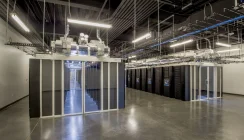How to Improve Datacentre Energy Efficiency Using Aisle Containment
The problem of how to efficiently cool server rooms and datacentres is become more complex. Today’s IT environment can include a mixture of IT servers including high density racks leading to ‘hot-spots’ within racks and spread throughout a server environment. Edge computing will increase the complexity of the problem using remote compute facilities that may be more exposed to external ambient temperatures.
Datacentres and server rooms have traditionally only relied upon computer room air conditioners referred to as ‘CRACs’. Within a server room, split AC units may be wall or ceiling mounted with an external condenser and heat exchanger. In a larger IT environment such as a datacentre, there may be one or more CRACs to chill and condition the air with the right moisture and humidity content. The air is then moved around the room via built-in fans and computer room air handlers (CRAHs) or delivered to the bottom of server racks via the raised access floor plenum and vented floor tiles. The cool air is drawn into the racks and the hot air expelled into a ‘free’ return path to the CRAC units.
This approach can be used effectively within a server room or smaller datacentre but the larger the facility the more difficult the task becomes. The problem is one of maintaining a stable a temperature and humidity-controlled environment within a large compute space which run to several hundred thousand cubic feet of air. Another problem arises in terms of equipment moves and maintaining an adequate seal around floor tiles to prevent cool air leakage. The exhaust heat from the racks can also be an issue if it mixes with cool air on its return to the CRACs.
Energy Efficient Cold Aisles
Cold aisle containment is a relatively easy way to arrange the server cabinets and reduce the amount of cool air required from the CRACs, thereby reducing energy consumption. The most readily accepted cold aisle containment approach is to arrange the racks into two facing rows and place an enclosure of this with doors at each end. Cool air can then be channelled into the cold aisle using positive pressure to push this to the server racks. To maximise the cold air flow, blanking plates should be fitted to any spaces in the front of the racks. The hot air is then expelled out of the racks and into the general computing area. The overall efficiency of this arrangement is higher than that of a CRAC as the cold air is being applied to the front area of the server racks rather than just to the front bottom through a vented floor tile.
The downside with a pure cold aisle arrangement is that the heat is expelled into the larger computing environment. This could then become very warm and uncomfortable for any technicians or engineers in the area. Temperature and environment monitoring are important to ensure that temperatures do not become excessive or present a health & safety or even a fire risk.
Energy Efficient Hot and Cold Aisle Installations
The deployment of a hot aisle can overcome these issues. With this arrangement, the hot air is contained within the hot aisles. Rather than being expelled into the computing room, the hot air is channelled into a return directly to the CRAC or cooling unit. There is little chance of the cold and hot air mixing, which would reduce cooling efficiency and the overall temperature within the computing area (outside the containment) is more comfortable for anyone working or visiting the installation. Overall this is a more energy efficient solution as the total air volumes are smaller and contained, reducing the overall load on the cooling system and therefore the energy required to cool the facility. Using a hot and cold aisle arrangement can reduce cooling demand by around 80% compared to that of a complete computer room.
Bespoke Aisle Containment Systems
At the high end of this approach, containment systems may be bespoke and manufactured to order. The overall system could contain the racks, high density racks, UPS systems, cooling system, air ducting, environment, temperature and pressure monitoring. The overall system would be studied at the design stage for computational fluid dynamics (CFD) to ensure air flow temperature and humidity specification and a calculation of the overall energy efficiency. Once the system is installed thermal imaging can be used to ensure there are no ‘hot-spots’ within the rows or server racks themselves. If there are any, these can then be tackled as an ‘in-situ’ project and the CFD results checked over for any deviations from the design or assumptions.
Further energy savings can be made using this arrangement by increasing the temperature of the compute area in line with ASHRAE standards. The overall inlet cooling air temperature can be raised as the air flow is contained, leading to lower cooling demands and therefore lower power consumption by the cooling system.
Summary
Both Cold and Cold/Hot Aisle arrangements can be used to improve energy efficiency within a server room or datacentre environment. Both applications improve cooling air flow and reduce the energy required by whichever cooling system is deployed including liquid cooling systems. Either design can also include a level of redundancy to ensure the overall operation meets the required level of resilience and Tier-functionality required for certification by the Uptime Institute. More info: https://uptimeinstitute.com/tiers

























